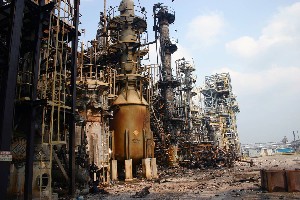Inside a pesticides plant with 520 employees, a 17-m³ reservoir used to treat methomyl residues in a methylisobutyl ketone (MTBK) solvent suddenly rose in pressure at 10:20 pm and exploded 15 min later, seriously damaging the production unit, ripping apart pipelines and causing a fire fuelled by the 8 m³ of product present in the reservoir. Onsite teams intervened, backed up by external fire-fighters, in application of a shared emergency protocol.
The site juxtaposed a major university and a river. Police closed the adjoining motorway. The operator’s inability to relay information to authorities, especially on eventual toxic products emitted, slowed the coordination of emergency response measures; the authorities ultimately decided to confine 40,000 individuals inside their homes for 3 hours. The fire was extinguished at 2:45 am.
Two employees, dispatched to verify the cause of a pressure alarm tripping on the tank, were killed (1 on the spot, the other 41 days later as a result of his burns). 6 fire-fighters and 2 employees with a railway company present onsite were intoxicated; 1 required hospitalisation for a day. Damage (mainly shattered windows) to buildings and vehicles was reported up to 10 km away in localities along the wind path, the majority of which lying within a 2.5-km radius. Damages outside the site boundary amounted to $37,000 (25,000).
A reservoir 25 m away, protected by an anti-projection shield and containing 6 tonnes of methyl isocyanate (MIC), was reached by debris yet did not leak, thereby preventing spreading of this highly toxic product, which had been implicated in the Bhopal disaster (ARIA 7022).
The investigation performed by the U.S. Federal Chemical Safety Agency (CSB) revealed that the accident was primarily due to organisational breakdowns: lack of appropriate oversight during the start-up phase with a new computerised control system; inadequate technician training in use of this new system; and noncompliance with written start-up procedures (which by the way had not been updated), including circumvention of critical risk mitigation measures. Other exacerbating factors were provided: insufficient safety report prior to installation restart, degraded equipment operations, poor communication during personnel shift changes, and employee fatigue due to working conditions at the time of facility restart (many overtime hours, considerable stress). Moreover, the operator sought to deliberately retain information, in particular relative to its MIC storage, under the false pretext of anti-terrorist laws.
The residue treatment tank as well as the unit’s entire control system had been changed during a long summer downtime period. Production was restarted prematurely due to strong product demand. Multiple problems on the production chain upstream of the residue treatment station drew all of the technicians’ attention and caused methomyl concentrations in the residues to exceed 20%, vs. an authorised maximum of 1%. Under normal operations, residues would have decomposed in the tank; the gases were treated and the solvent used as a combustible in other parts of the plant.
With a key safety backup device bypassed, the treatment tank not pre-filled using “clean” solvent and preheated, and a very high liquid level (due to an automatic regulator forced into manual mode), the overly concentrated residues caused a runaway reaction that led to the treatment tank explosion.
In 2010, the operator accepted to pay a fine of $143,000 (100,000) for violating federal regulations regarding workplace safety (poorly planned operating procedures, flawed backup systems, inadequate personnel training, etc.). In a plea bargain, 4 of the 13 counts against the operator were dropped.
An analysis of the daily MIC reservoir concluded that the reservoir structure only provided marginal protection in terms of impact energy absorption from large fragments at high speeds, which were capable of being induced by an explosion like this one. Had the residue treatment station been projected in the direction of the daily MIC reservoir and slammed against the shield structure, then the unloading valve ventilation pipe might have been damaged, thus causing a release of highly toxic MIC vapour into the atmosphere, leading to even more catastrophic consequences in an urban sector. After the accident, the operator halted onsite production of methomyl, in addition to reducing MIC storage volume by 80%, eliminating all surface MIC supplies, and modifying the technical risk analysis of MIC production.
Download the detailed report in .pdf format (554 Kb)





